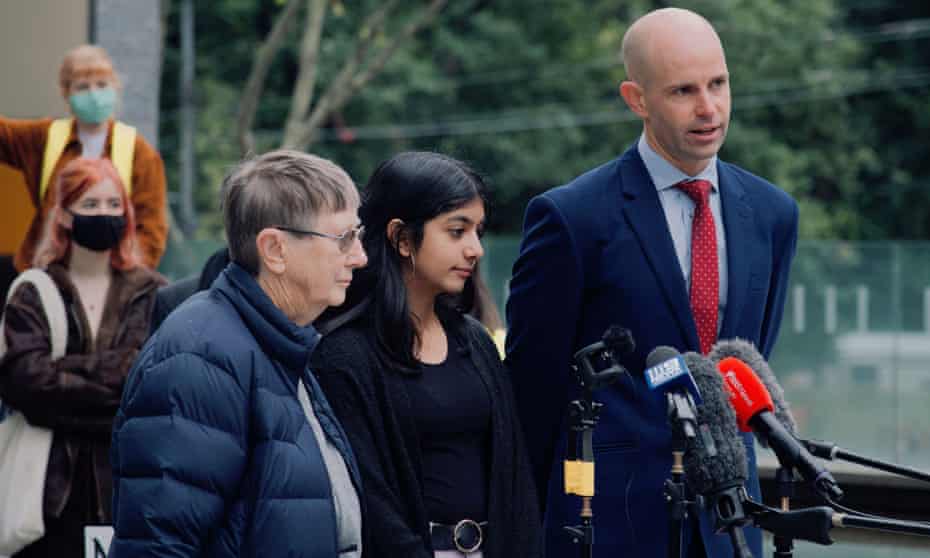Extract from The Guardian
There’s a growing trend of climate litigation around the world. Here’s a look at the Australian cases likely to make headlines this year.

In a case brought by Anj Sharma with Sister Brigid Arthur, a judge ruled the environment minister owed Australian children a duty of care to mitigate the impact of climate change.
The lawsuit brought by Anj Sharma, along with seven other teenagers, and Sister Brigid Arthur, is part of a growing trend among climate activists and environment organisations raising climate issues in the courtroom, amid a lack of action by the federal government.
It is also consistent with a trend around the globe, with high-profile cases internationally against the likes of oil company Shell and the Dutch government.
Australia now sits second on a climate litigation league table, behind only the United States.
As the legal year begins, Guardian Australia outlines the major climate cases likely to make headlines in the months ahead.
A climate duty of care?
Environment Minister v Sharma
The
devastating impact of the impending climate crisis “will largely be
inflicted by the inaction of this generation of adults, in what might
fairly be described as the greatest inter-generational injustice ever
inflicted,” wrote
Justice Mordecai Bromberg last May. With that hard-hitting truth, the
federal court judge held that the environment minister, Sussan Ley, owed
Australian children a duty of care to mitigate the impact of climate
change, which was relevant as she considered approving a major coal mine
expansion. Sharma, the lawsuit brought by Anj Sharma, seven other
teenagers, and Sister Brigid Arthur, is the most seismic climate
judgment in Australia to date.
Unsurprisingly, the environment minister appealed. While the first-instance case focused on the application of orthodox legal principles to a changing world, the federal government upped the stakes in the full federal court last October, arguing that the political nature of the case made it unsuited for judicial resolution.
The decision is due soon; whatever the outcome, it is likely destined for the high court. Sharma is immensely significant because, grounded in common law negligence rather than administrative law, it cannot be easily overwritten by legislation. If the case holds on appeal, expect similar challenges – both to government decision-making and private sector emitters.
Rising sea levels
Pabai v Commonwealth
Similar issues are being argued in Pabai, on an even larger scale, in a case brought by two Torres Strait Islanders. They argue that the federal government as a whole is acting negligently in failing to save the Torres Strait Islands from rising sea levels. The plaintiffs point to the Torres Strait treaty (with Papua New Guinea), native title law and other government initiatives in the region to underscore the duty of care they believe is owed. Failure to act, the pair’s lawyers argue, “will have severe impacts on Torres Strait Islanders, including, injury, disease, and death, rendering some of the islands uninhabitable and displacing Torres Strait Islanders, causing them to become climate refugees”.

The federal court case is listed for a case management conference in March. There has been some discussion about taking evidence in the Torres Strait, which means that a quick resolution is unlikely; at the earliest, a judgment might be delivered by the end of the year.
Climate (in)action and human rights
Youth Verdict v Waratah Coal
In other countries, much successful climate litigation has been focused on human rights obligations. Yet in Australia, in the absence of constitutionally-entrenched rights or a federal charter of rights, such cases have failed to get off the ground. Until now.
After Queensland enacted its Human Rights Act in 2019, a coalition of young Queenslanders – Youth Verdict – challenged Clive Palmer’s proposed Galilee basin coal mine. They are arguing that the mine, which would dig up 40 megatonnes of thermal coal each year, violates their right to life, Indigenous cultural rights, rights of children and the right to freedom from discrimination.
In late 2020, the group’s claim survived its first test – a preliminary application by Palmer’s company to prevent Youth Verdict relying on human rights grounds in challenging the proposed mine. The relevance of human rights to the mine proposal will be considered in more detail in the coming months.
Corporate greenwashing?
Australasian Centre for Corporation Responsibility v Santos
Are major emitters misleading investors when they claim to have a “credible and clear plan” to achieve “net zero” in the coming decades, in the (alleged) absence of such an achievable plan? Is it unlawful to call natural gas “clean energy”, given it is a fossil fuel? These are among the questions to be argued between energy major Santos and shareholder group the Australasian Centre for Corporate Responsibility, in a world-first test case filed last year in the federal court.
If the ACCR is successful, Australian companies will have to be much more careful in communicating on climate issues, lest they be in breach of corporate and consumer law. The parties are currently undertaking discovery, with the case expected to be heard mid-year.
Failure to disclose climate risk
O’Donnell v Commonwealth
In another world-first case, a Victorian law student is suing the federal government. Katta O’Donnell alleges the government is misleading investors, and therefore breaching corporate law, by failing to adequately disclose climate risks when issuing long-term sovereign bonds. Last year, the government tried to have the case thrown out, but lost – with Justice Bernard Murphy holding that the plaintiff had set out an arguable case and should be permitted access to government documents to refine her claim. The case will be heard late this year. If the law student wins, O’Donnell could have a major impact globally on the way governments disclose climate risk in financial settings.
The next wave of climate litigation
The first climate case in Australia was brought in 1994, when Greenpeace challenged the construction of a coal-fired power station. In the subsequent decades, most climate litigation has been grounded in administrative law – challenging government decision-making that insufficiently mitigated or entirely ignored climate impact. It is only in recent years that improved science and continuing government and corporate inaction has prompted more creative climate lawyering, using tort law, corporate law, human rights law and beyond.
That trend is set to continue. Last year, significant climate litigation cases were filed almost monthly; even more are anticipated this year. “As a nation, we are starting to wake up to how exposed we are to the risks of climate change,” David Barnden, who has masterminded several recent climate cases, previously told Guardian Australia. “The law will respond to that.”
No comments:
Post a Comment